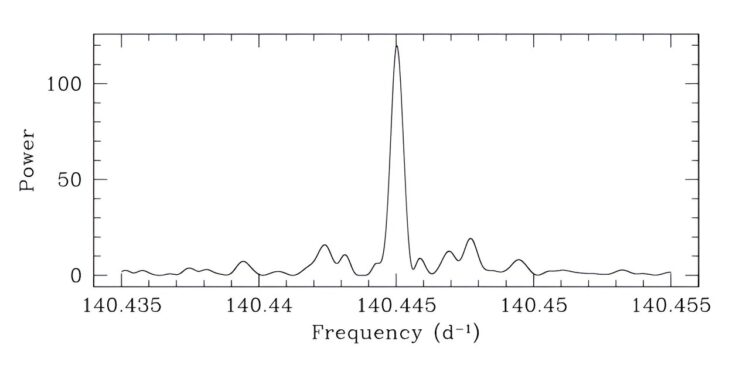Scargle periodogram of J0526+5934 resulting from analysis of ZTF data. Credit: Rebassa-Mansergas et al., 2024.
Using ground-based telescopes, an international team of astronomers observed a binary system containing at least one white dwarf, designated J0526+5934. The observation campaign revealed that the binary is composed of two white dwarfs over an ultra-short period. The discovery was reported in a paper published February 6 on the preprint server. arXiv.
White dwarfs (WDs) are stellar cores left behind after a star has exhausted its nuclear fuel. Due to their strong gravity, they are known to have atmospheres of pure hydrogen or pure helium. However, a small fraction of WDs show traces of heavier elements.
Astronomers are interested in discovering and studying double white dwarfs (DWDs) because their mergers are thought to produce new white dwarfs with higher masses. However, although the galactic population of DWD is estimated to be several hundred million, only a small fraction of the observable population has been discovered to date.
J0526+5934 was initially identified in 2019 as an extremely low mass (ELM) white dwarf candidate. Further observations of this object revealed that it is a binary system consisting of an invisible primary white dwarf almost as massive as the sun and a visible companion, with a mass of about 0.38 solar mass, which can be a white dwarf or a low-mass white dwarf. dwarf.
Now, new observations by a group of astronomers led by Alberto Rebassa-Mansergas of the Technical University of Catalonia in Barcelona, Spain, shed more light on the properties of this system, indicating a white dwarf nature of the secondary star.
First, the observations revealed that the visible component of J0526+5934 is less massive than previously estimated. The data indicates that this object has a mass of only 0.26 solar masses, so it was classified as an ELM white dwarf.
According to the study, the visible WD ELM has a radius of approximately 0.065 solar radii and its effective temperature is at a level of 27,330 K. The star has a helium surface abundance (He/H) of approximately -2.20 dex and its cooling age was estimated at 260 million years.
As for the invisible white dwarf, the results suggest that it has a mass of around 0.71 solar masses. Astronomers assume that its effective temperature is below 6,700 K.
Since the orbital period of J0526+5934 was measured to be around 0.342 hours, the paper’s authors classified the system as a detached, ultra-short-period binary double white dwarf. This is the fifth such system discovered so far.
Summarizing the results, the researchers concluded that the two components of J0526+5934 will merge in about 3 million years, resulting in the formation of a massive white dwarf, with a mass comparable to that of the sun.
More information:
Alberto Rebassa-Mansergas et al, J0526+5934: a particular double white dwarf with an ultra-short period, arXiv (2024). DOI: 10.48550/arxiv.2402.04443
Journal information:
arXiv
© 2024 Science X Network
Quote: J0526+5934 is a double white dwarf with an ultra-short period, according to observations (February 14, 2024) retrieved on February 14, 2024 from
This document is subject to copyright. Except for fair use for private study or research purposes, no part may be reproduced without written permission. The content is provided for information only.



